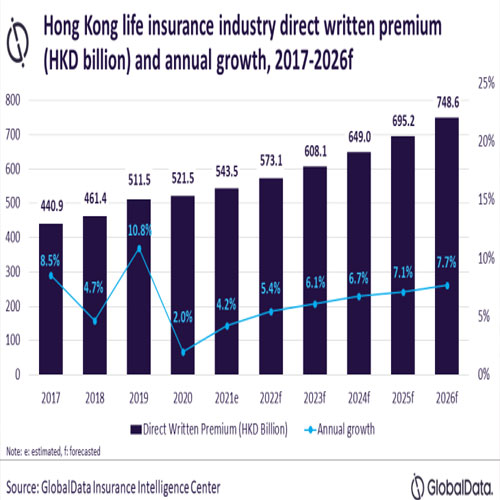China life insurance industry to reach $665 billion by 2026

The Chinese life insurance industry is set to grow at a compound annual growth rate (CAGR) of 6.3% from CNY3.1 trillion ($484.4 billion) in 2021 to CNY4.25 trillion ($665.6 billion) in 2026, in terms of direct written premiums (DWP), supported by a recovery in the agency distribution channel and product innovations that address changing demographic requirements, says GlobalData, a leading data and analytics company.
GlobalData’s Global Insurance Database reveals that agencies and bancassurance are the main channels of life insurance distribution in China, accounting for a 60.1% and 30% share in new business DWP in 2021, respectively. The agency channel registered a 2.2% growth in 2021, driven by investments from insurers to upgrade the quality of advisory services through training, while bancassurance recorded a 3.9% growth.
Deblina Mitra, Senior Insurance analyst at GlobalData, comments: “Agencies are the main distribution channel for whole life insurance products, which accounted for 75% of life insurance DWP in China in 2021. Over 85% of high net worth (HNW) investors in China prefer life insurance in their inheritance planning, which is one of the main drivers of whole life insurance. The affluent population is expected to grow at an average annual growth of 9% over the next five years, boosting the demand for life insurance.”
The life insurance industry in China also benefitted from the growing demand for personal accident and health (PA&H) insurance, driven by a rise in private healthcare facilities and disposable income. Life PA&H insurance occupied a 24.5% share of the DWP in 2021, with a CAGR of 13.8% during 2017–21.
Hybrid insurance products, which combine healthcare and protection with savings, have also gained prominence in the country. For instance, ‘elderly home care service’, a hybrid insurance by Pin An Life to provide long-term care to the elderly, was launched in March 2022. It covers round-the-clock health and other assistant services to elderly people.
Mitra adds: “Whole life and annuity insurance with riders, such as critical illness and accident, are the other examples of hybrid insurance products in China. The large middle-income population, which is expected to reach 90% by 2030, and the aging demography in China are the key consumers of these products.”
In April 2022, China witnessed the rollout of individual private pensions, as part of the third pillar of pension, to address income challenges faced by the aged population. The third pension pillar will allow individuals to contribute up to CNY12,000 ($1,872) annually, which will be tax exempted and can be invested in products such as commercial endowments from life insurers.
Mitra continues: “The current pension system with state pension covering 70% of the population and voluntary employee pensions is deemed inadequate to fully support China’s retirement requirements. The new pension plan has opened an untapped opportunity for insurers.”
In 2021, after the foreign direct investment (FDI) cap on insurance was scrapped in China, many foreign insurers such as Allianz, and Manulife announced their expansion, with a keen interest in the pension sector.
Mitra concludes: “The life insurance industry in China is expected to weather the ongoing economic slowdown caused by frequent lockdowns and will expand over the next five years, aided by an influx of foreign capital.”
See What’s Next in Tech With the Fast Forward Newsletter
Tweets From @varindiamag
Nothing to see here - yet
When they Tweet, their Tweets will show up here.






























